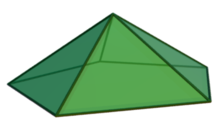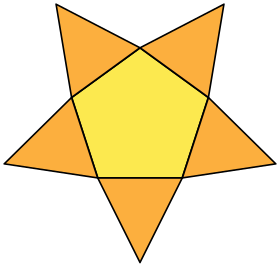User:Dedhert.Jr/sandbox/2
| Dedhert.Jr/sandbox/2 | |
|---|---|
 | |
| Type | Johnson J1 – J2 – J3 |
| Faces | 5 triangles 1 pentagon |
| Edges | 10 |
| Vertices | 6 |
| Vertex configuration | [1] |
| Symmetry group | |
| Dual polyhedron | self-dual |
| Properties | convex |
| Net | |
 | |

In geometry, pentagonal pyramid is a pyramid with a pentagon base and five triangular faces, having a total of six faces. If all of the edges are equal in length, the triangular faces are equilateral, and this pyramid is the second Johnson solid . The pentagonal pyramid can be found in many polyhedrons, especially in constructing new polyhedra. Its structure can be used in stereochemistry.
Properties[edit]
A pentagonal pyramid has six vertices, ten edges, and six faces. One of its faces is pentagon, a base of the pyramid; five others are triangles.[2] Five of the edges make up the pentagon by connecting its five vertices, and the other five edges are known as the lateral edges of the pyramid, meeting at the sixth vertex called the apex.[3] When all edges are equal in length, the five triangular faces are equilateral and the base is a regular pentagon. This pyramid has the property of Johnson solid , a convex polyhedron that all of the faces are regular polygons.[4] The dihedral angle between two adjacent triangular faces and that between the triangular face and the base is and , respectively. Like other right pyramids with a regular polygon as a base, this pyramid has pyramidal symmetry of cyclic group : the pyramid is left invariant by rotations of one, two, three, and four in five of a full turn around its axis of symmetry, the line connecting the apex to the center of the base. It is also mirror symmetric relative to any perpendicular plane passing through a bisector of the base.[1] It can be represented as the wheel graph ; more generally, a wheel graph is the representation of the skeleton of a -sided pyramid.[5]
Given that is the length of all edges of the pentagonal pyramid. A polyhedron's surface area is the sum of the areas of its faces. Therefore, the surface area of a pentagonal pyramid is the sum of the four triangles and one pentagon area. In the case of Johnson solid, the surface area is given the expression:[6]
Applications[edit]
In the appearance and construction of polyhedra[edit]
Pentagonal pyramids can be found in many polyhedrons as their component. Its base attaching to the pentagonal face of another polyhedron to construct new polyhedra is an example of the construction process known as augmentation, and attaching to prisms or antiprisms is known as elongation or gyroelongation, respectively.[8] A dodecahedron is a quintessence polyhedron, where the pentagonal pyramids attached to its pentagonal faces, constructing a pentakis dodecahedron.[9] Small stellated dodecahedron is a dodecahedron stellated by pentagonal pyramids.[10]
Some Johnson solids are constructed by either augmenting pentagonal pyramids or augmenting other shapes with pentagonal pyramids: elongated pentagonal pyramid , gyroelongated pentagonal pyramid , pentagonal bipyramid , elongated pentagonal bipyramid , augmented dodecahedron , parabiaugmented dodecahedron , metabiaugmented dodecahedron , and triaugmented dodecahedron .[11] Relatedly, the removal of a pentagonal pyramid from polyhedra is an example known as diminishment; metabidiminished icosahedron and tridiminished icosahedron are the examples that removed pentagonal pyramids from a regular icosahedron.[6]
Stereochemistry[edit]
In stereochemistry, an atom cluster can have a pentagonal pyramidal geometry. This molecule has a main-group element with one active lone pair, which can be described by a model that predicts the geometry of molecules known as VSEPR theory.[12]
Notes[edit]
- ^ a b Johnson (1966).
- ^ Ball & Coxeter (1987), p. 130; Grgić et al. (2022), p. 476.
- ^ Smith (2000), p. 98.
- ^ Uehara (2020), p. 62.
- ^ Pisanski & Servatius (2013), p. 21.
- ^ a b c Berman (1971).
- ^ Calter & Calter (2011), p. 198.
- ^ Slobodan, Obradović & Ðukanović (2015).
- ^ Çolak & Gelişgen (2015).
- ^ Kappraff (2001), p. 309.
- ^ Rajwade (2001), pp. 84–88. See Table 12.3, where denotes the -sided prism and denotes the -sided antiprism.
- ^ Petrucci, Harwood & Herring (2002), p. 414.
References[edit]
- Ball, W. W. R.; Coxeter, H. S. M. (1987). Mathematical Recreations and Essays. Dover Publications.
- Berman, Martin (1971). "Regular-faced convex polyhedra". Journal of the Franklin Institute. 291 (5): 329–352. doi:10.1016/0016-0032(71)90071-8. MR 0290245.
- Calter, Paul A.; Calter, Michael A. (2011). Technical Mathematics. John & Sons Wiley.
- Çolak, Zeynep; Gelişgen, Özcan (2015). "New Metrics for Deltoidal Hexacontahedron and Pentakis Dodecahedron". Sakarya University Journal of Science. 19 (3): 353–360. doi:10.16984/saufenbilder.03497.
- Grgić, Ivan; Karakašić, Mirko; Ivandić, Željko; Glavaš, Hrvoje (2022). "Maintaining the Descriptive Geometry's Design Knowledge". In Glavaš, Hrvoje; Hadzima-Nyarko, Marijana; Karakašić, Mirko; Ademović, Naida; Avdaković, Samir (eds.). 30th International Conference on Organization and Technology of Maintenance (OTO 2021): Proceedings of 30th International Conference on Organization and Technology of Maintenance (OTO 2021). International Conference on Organization and Technology of Maintenance. doi:10.1007/978-3-030-92851-3.
- Johnson, Norman W. (1966). "Convex polyhedra with regular faces". Canadian Journal of Mathematics. 18: 169–200. doi:10.4153/cjm-1966-021-8. MR 0185507. S2CID 122006114. Zbl 0132.14603.
- Kappraff, Jay (2001). Connections: The Geometric Bridge Between Art and Science (2nd ed.). World Scientific. ISBN 981-02-4585-8.
- Petrucci, Ralph H.; Harwood, William S.; Herring, F. Geoffrey (2002). General Chemistry: Principles and Modern Applications. Vol. 1. Prentice Hall. ISBN 9780130143297.
- Pisanski, Tomaž; Servatius, Brigitte (2013). Configuration from a Graphical Viewpoint. Springer. doi:10.1007/978-0-8176-8364-1. ISBN 978-0-8176-8363-4.
- Rajwade, A. R. (2001). Convex Polyhedra with Regularity Conditions and Hilbert's Third Problem. Texts and Readings in Mathematics. Hindustan Book Agency. doi:10.1007/978-93-86279-06-4. ISBN 978-93-86279-06-4.
- Slobodan, Mišić; Obradović, Marija; Ðukanović, Gordana (2015). "Composite Concave Cupolae as Geometric and Architectural Forms" (PDF). Journal for Geometry and Graphics. 19 (1): 79–91.
- Smith, James T. (2000). Methods of Geometry. John Wiley & Sons. ISBN 0-471-25183-6.
- Uehara, Ryuhei (2020). Introduction to Computational Origami: The World of New Computational Geometry. Springer. doi:10.1007/978-981-15-4470-5. ISBN 978-981-15-4470-5.
- Wohlleben, Eva (2019). "Duality in Non-Polyhedral Bodies Part I: Polyliner". In Cocchiarella, Luigi (ed.). ICGG 2018 - Proceedings of the 18th International Conference on Geometry and Graphics: 40th Anniversary - Milan, Italy, August 3-7, 2018. International Conference on Geometry and Graphics. Springer. doi:10.1007/978-3-319-95588-9. ISBN 978-3-319-95588-9.
- Pentakis dodecahedron, snub dodecahedron,
- Truncated order-5 cubic honeycomb
- VSEPR theory
- Maybe I can explain the diminishment of Johnson solid?
- Pentagonal pyramidal molecular geometry
- https://books.google.com/books?id=sfc2OEuE8oQC&pg=PA170 (snub dodecahedron and icosidodecahedron)
- Probably need Cartesian coordinates as its construction, and relating it with the mensuration.



























